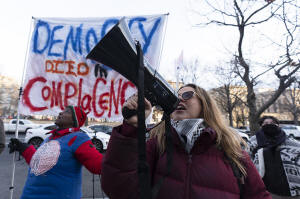Trump administration begins sweeping layoffs with probationary workers,
warns of larger cuts to come
 Send a link to a friend
Send a link to a friend
 [February 14, 2025]
By CHRIS MEGERIAN and MICHELLE L. PRICE [February 14, 2025]
By CHRIS MEGERIAN and MICHELLE L. PRICE
WASHINGTON (AP) — The Trump administration on Thursday intensified its
sweeping efforts to shrink the size of the federal workforce, the
nation's largest employer, by ordering agencies to lay off nearly all
probationary employees who had not yet gained civil service protection —
potentially affecting hundreds of thousands of workers.
In addition, workers at some agencies were warned that large workplace
cuts would be coming.
The decision on probationary workers, who generally have less than a
year on the job, came from the Office of Personnel Management, which
serves as a human resources department for the federal government. The
notification was confirmed by a person familiar with the matter, who
spoke on condition of anonymity because they were not authorized to
discuss it publicly.
Even workers in the personnel office itself were not immune: Dozens of
probationary employees at OPM were told on a Thursday afternoon group
call that they were being dismissed and then instructed to leave the
building within a half-hour, according to another person who likewise
spoke on condition of anonymity.
It’s expected to be the first step in sweeping layoffs. President Donald
Trump signed an executive order Tuesday that told agency leaders to plan
for “large-scale reductions in force.”
Elon Musk, whom President Trump has given wide leeway to slash
government spending with his Department of Government Efficiency, called
Thursday for the elimination of whole agencies.
“I think we do need to delete entire agencies as opposed to leave a lot
of them behind,” Musk said via a videocall to the World Governments
Summit in Dubai, United Arab Emirates. “If we don’t remove the roots of
the weed, then it’s easy for the weed to grow back.”
Everett Kelley, the president of the American Federation of Government
Employees representing federal workers, said the administration “abused”
the probation status of workers “to conduct a politically driven mass
firing spree, targeting employees not because of performance, but
because they were hired before Trump took office.”

Thursday's order was an expansion of previous directions from OPM, which
told agencies earlier this week that probationary employees should be
fired if they weren’t meeting high standards. It’s not clear how many
workers are currently in a probationary period. According to government
data maintained by OPM, as of March 2024, 220,000 workers had less than
a year on the job — the most recent data available.
The firing of probationary employees began earlier this week and has
included the Consumer Financial Protection Bureau and the Department of
Education workers.
At least 39 were fired from the Education Department on Wednesday,
according to a union that represents agency workers, including civil
rights workers, special education specialists and student aid officials.
The layoffs also hit Department of Veterans Affairs researchers working
on cancer treatment, opioid addiction, prosthetics and burn pit
exposure, U.S. Sen. Patty Murray, a Democrat, said Thursday.
Murray said in a statement that she heard from VA researchers in her
state who were told to stop their research immediately, “not because
their work isn’t desperately needed, but because Trump and Elon have
decided to fire these researchers on a whim.”
Public Employees for Environmental Responsibility, a group that defends
government workers, said the Agriculture Department’s Food Safety and
Inspection Service would be hit especially hard by laying off
probationary employees because it has trouble recruiting inspectors
required to be present at all times at most slaughterhouses.
[to top of second column]
|

Carrie Muniak joins a rally in front of the Office of Personnel
Management, Monday, Feb. 3, 2025, in Washington. President Donald
Trump is relying on a relatively obscure federal agency to reshape
government. The Office of Personnel Management was created in 1979
by President Jimmy Carter and is the equivalent of the government's
human resources department. It helps manage the civil service,
including pay schedules, health insurance and pension programs. The
agency has offered millions of federal workers eight months of
salary if they voluntarily choose to leave their jobs by Feb. 6. (AP
Photo/Manuel Balce Ceneta)

The civilian federal workforce , not including military personnel
and postal workers, is made up of about 2.4 million people. While
about 20% of the workers are in Washington D.C., and the neighboring
states of Maryland and Virginia, more than 80% live outside the
Capitol region.
Layoffs are unlikely to yield significant deficit savings. When the
Congressional Budget Office looked at the issue, it found the
government spent $271 billion annually compensating civilian federal
workers, with about 60% of that total going to workers employed by
the departments of Defense, Homeland Security and Veterans Affairs.
The government could, in theory, cut all those workers and still run
a deficit of over $1 trillion that would continue to grow as tax
revenues are needed to keep up with the growing costs of Social
Security and Medicare.
Elaine Kamarck, a senior fellow at the Brookings Institution, said
firing employees on probation is flawed because it targets younger
workers.
“Baby Boomers are retiring right and left, so actually the people
you want to keep are probably most of the people who are right now
on probation," said Kamarck, who worked in former President Bill
Clinton’s Democratic administration when about 426,000 federal jobs
were cut over more than eight years in a deliberative effort aimed
at reinventing government. "They’re younger and presumably have
better skills, and that’s who you want."
Trump’s initial attempt to downsize the workforce was the deferred
resignation program, commonly described as a buyout, which offered
to pay people until Sept. 30 if they agreed to quit. The White House
said 75,000 people signed up, and a federal judge cleared a legal
roadblock for the program Wednesday.
However, the number of workers who took the offer was less than the
administration’s target, and Trump has made it clear he would take
further steps.
Employees at the National Science Foundation and Housing and Urban
Development Department were told this week that large reductions, in
some cases a halving of the workforce, would be coming, according to
a person familiar with the situation who spoke on condition of
anonymity because they were not authorized to discuss it.
The order Trump signed Tuesday stipulated that government functions
not required by law would be prioritized for cuts and hiring will be
restricted. With exceptions for functions such as public safety,
only one employee can be added for every four that leave. In
addition, new hires would generally need approval from a
representative of the DOGE, expanding the influence of Musk’s team.
Trump has praised Musk’s work to slash federal spending.
The Republican president has also been sharply critical of federal
workers, especially those who want to keep working remotely, though
his administration is simultaneously working to cut federal office
space and ordering the termination of worksite leases throughout the
government.
“Nobody is gonna work from home,” Trump said Monday. “They are gonna
be going out, they’re gonna play tennis, they’re gonna play golf,
they’re gonna do a lot of things. They’re not working.”
___
Price reported from New York. Associated Press writers Will Weissert,
Lisa Mascaro, Josh Boak and Collin Binkley in Washington; Carla
Johnson in Seattle; Brian Witte in Annapolis, Maryland; and JoNel
Aleccia in Los Angeles contributed to this report.
All contents © copyright 2025 Associated Press. All rights reserved |